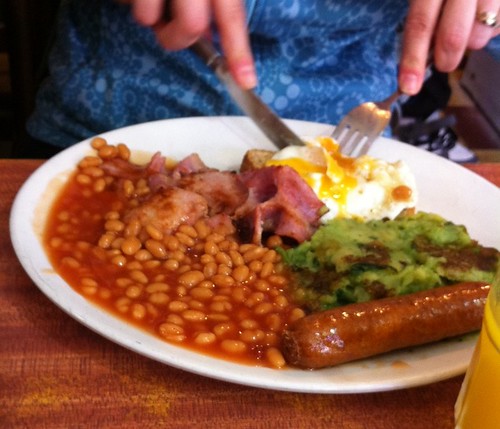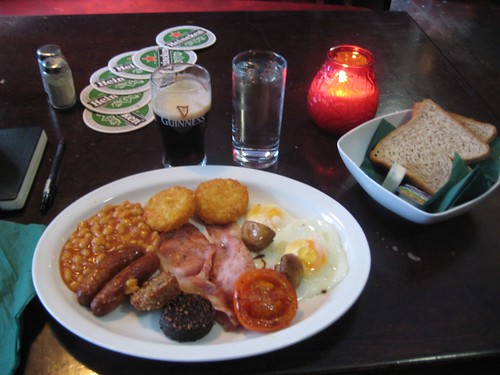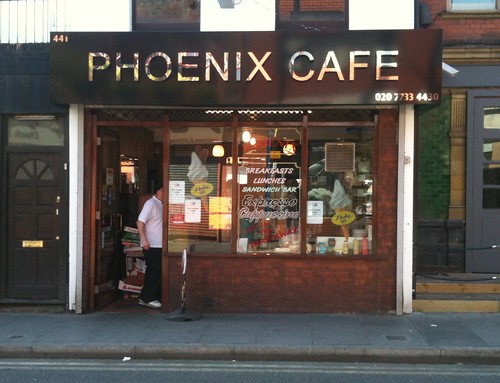I mentioned in my last post that I recently had a visit from my sister and brother-in-law who came over for an 8-day whirlwind tour of London (with a brief overnighter in York, just to spice things up). They arrived on a Friday, which was an excellent excuse for me to take the day off work to show them the sights. And since they landed at an ungodly hour in the morning it seemed only appropriate that we fuel up with a proper breakfast before hitting the town. After fetching them from Victoria Station and forcing them to drag their wheelie bags through the Underground and up the stairs at Brixton station, I gave them the choice of two places for breakfast. (Note to self: making people who’ve been up for more than 24 hours and have just flown through seven time zones make decisions about where to eat turns out to be asking a bit much.) The choice was between the traditional greasy spoon caf I ate at the morning I visited Brixton Market, and a place I discovered after waddling out of that caf and crossing the street, which seemed a fair bit more upmarket, and potentially interesting. There was a bit of faffing around, but they eventually chose the traditional route, so in we went to the Phoenix Cafe for a Full English Breakfast. (Note: That’s not a spelling error above. “Caf” is the correct colloquial abbreviation for the kind of down home place where you can expect to get a proper Full English Breakfast. A caf is the UK equivalent of a greasy spoon.)
For those who have never had the pleasure, the Full English Breakfast (often abbreviated to simply the Full English) is an artery-clogging, gut-busting delight, best attempted when hung over or jetlagged. Like its North American cousin, the Full English starts with eggs and breakfast meats but it’s the local variations that make it special. Here are what I’d consider the basic components of a standard Full English Breakfast:

In addition the these variations there are regional differences that crop up when you cross a border. For instance, while black pudding is relatively uncommon in the Full English, the Full Scottish Breakfast would seem incomplete without it. White pudding also makes regular appearances in the Full Scottish. Regional bread products are also often encountered, such as soda bread or farl (fried - of course - potato bread) with the Full Irish, or tattie scones north of Hadrian’s wall. Apparently the Welsh even do some kind of pan-fried carbohydrate called laverbread which consists of “seaweed purée which is then mixed with oatmeal, formed into patties and fried in bacon fat” (of course). Ahhh, those wacky Welshmen.
 Pictured above is an Amsterdam Irish Pub/Hostel’s take on the Full Irish Breakfast, served to me on a bleary morning after an overnight train ride from Copenhagen. Black pudding is pictured in the foreground, with a very unusual appearance by tater-tot style hashbrowns at the top of the plate. And yes, that’s a half a pint of Guinness in the background. What can I say? It was a long night.
Pictured above is an Amsterdam Irish Pub/Hostel’s take on the Full Irish Breakfast, served to me on a bleary morning after an overnight train ride from Copenhagen. Black pudding is pictured in the foreground, with a very unusual appearance by tater-tot style hashbrowns at the top of the plate. And yes, that’s a half a pint of Guinness in the background. What can I say? It was a long night.
The label says “Baked beans in tomato sauce with sausage, button mushrooms, chopped pork and egg nuggets with cereal and bacon.” Shudder. The entire contents of the can are meant to be tipped into a pot and heated gently (“Do not boil”, it says, as if to imply that over-heating will ruin the delicate nuances of flavour in the egg nuggets). But really, for the love of God, what is an egg nugget? And how can cereal possibly be included in the above list? Even I, primary participant in the Steve’s Weird Food project at my last blog, have not yet mustered the courage or intestinal fortitude to open that can. (Or perhaps I just haven't been hungover enough and house-bound enough at the same time). Because in the end, the Phoenix Cafe is just a short walk away and I am perfectly certain that they will never, ever serve me an egg nugget.
For those who have never had the pleasure, the Full English Breakfast (often abbreviated to simply the Full English) is an artery-clogging, gut-busting delight, best attempted when hung over or jetlagged. Like its North American cousin, the Full English starts with eggs and breakfast meats but it’s the local variations that make it special. Here are what I’d consider the basic components of a standard Full English Breakfast:
- Eggs - usually two and always fried. I have never been asked how I’d like my eggs when ordering a Full English. I suppose it’s theoretically possible to have scrambled eggs, but I wouldn’t want to be the one to ask. And poached? Well it just doesn’t seem to be in the right spirit at all. You might as well order the Vegetarian Full English which is a bastardization of the form I will not stoop to discuss here.
- Sausages – normally the standard breakfast sausage variety, unless you’re somewhere posh where they will be artisanal Cumberland sausages made from pigs raised on a diet of truffles and sparkling water or some such menu-speak rubbish.
- Bacon - it’s important to note that bacon in England is not like bacon at home. It definitely comes from a completely different part of the pig and is more like what we’d call back bacon or what Americans inexplicably call Canadian bacon. What we know of as bacon is here called “streaky bacon”. In fact bacon in general, and the incomparable bacon sandwich (or, more properly, bacon sarnie) might possibly warrant a separate blog post, since it seems to be an entire food group over here.
- Baked Beans – Yes, beans. The kind that come in a can, traditionally with a blue label emblazoned with “Heinz”. They are an indispensable part of the Full English Breakfast and form a sort of puddle that the rest of the items nestle in/around.
- Toast – usually with a choice of white or whole wheat, buttered, normally served on a side plate, and never accompanied by anything so hospitable as a bit of jam or peanut butter. You can often get some kind of sweet spread on request but often it’s best just to use your toast to sop up the beans.
- Tea or coffee – In the case of a really traditional caf, the coffee will almost certainly be instant but is often served mixed with frothy milk that makes it quite tasty.
- Mushrooms – fried, of course. Plain button mushroom, sliced and fried up. Or in a more posh place, big whole mushroom caps.
- Tomatoes – fried, of course. Either slices of tomato, or a whole tomato cut in half. Sometimes put under the broiler (grill) instead of being fried.
- Fried Slice – bread, fried of course. I think it may actually be fried in the bacon fat. Or possibly deep-fried. I’ve only had it once, and that was enough.
- Bubble and Squeak – referred to simply as “bubble” by those in the know. Bubble and Squeak is a traditional dish in its own right, composed of leftover mashed potatoes mixed with leftover vegetables, most usually cooked cabbage. The variety at the Phoenix Café is an alarming shade of green, but really tasty. Bubble in a Full English is normally pan-fried. Of course.
- Black Pudding – fried, of course. And yes, it’s sausage made out of blood, but give it a chance! Black pudding is actually quite tasty and spicy, with a smooth-ish texture and a nice peppery kick. Served as a large round slice and fried (of course) so the outside is sort of crispy.
- Chips – Did you honestly think that the English would let a meal go by without the opportunity to eat chips?

The Phoenix Cafe’s Full English Breakfast. Note the Sea O’ Beans and the martian-coloured bubble. Also pictured: The Partial Canadian Sister. (On the issue of the Sea o’ Beans, I feel compelled to pass on this crucial travel tip for anyone planning on ordering a Full English Breakfast in Spain. Apparently the wily Spanish purveyors of the FEB are known to overload on the beans in order to bulk up the plate at low cost. Therefore the wise traveler will order his or her FEB without any beans at all in order to force the cook to serve up a proper amount of the really good stuff like bacon and sausages. Thanks for the tip Patrick!)
 Pictured above is an Amsterdam Irish Pub/Hostel’s take on the Full Irish Breakfast, served to me on a bleary morning after an overnight train ride from Copenhagen. Black pudding is pictured in the foreground, with a very unusual appearance by tater-tot style hashbrowns at the top of the plate. And yes, that’s a half a pint of Guinness in the background. What can I say? It was a long night.
Pictured above is an Amsterdam Irish Pub/Hostel’s take on the Full Irish Breakfast, served to me on a bleary morning after an overnight train ride from Copenhagen. Black pudding is pictured in the foreground, with a very unusual appearance by tater-tot style hashbrowns at the top of the plate. And yes, that’s a half a pint of Guinness in the background. What can I say? It was a long night.
You may have noticed that almost all of the elements of the FEB are fried – beans and coffee being the only two ingredients that escape the pan with relative certainty. For this reason a full breakfast is often called a fry-up. (The Northern Ireland variety is known as an Ulster Fry.)
Finally, I have to report on a particularly terrifying bastard child of the Full English Breakfast that I could not help but purchase when I saw it in a Sainsbury’s several months ago. Behold, the horror:
The label says “Baked beans in tomato sauce with sausage, button mushrooms, chopped pork and egg nuggets with cereal and bacon.” Shudder. The entire contents of the can are meant to be tipped into a pot and heated gently (“Do not boil”, it says, as if to imply that over-heating will ruin the delicate nuances of flavour in the egg nuggets). But really, for the love of God, what is an egg nugget? And how can cereal possibly be included in the above list? Even I, primary participant in the Steve’s Weird Food project at my last blog, have not yet mustered the courage or intestinal fortitude to open that can. (Or perhaps I just haven't been hungover enough and house-bound enough at the same time). Because in the end, the Phoenix Cafe is just a short walk away and I am perfectly certain that they will never, ever serve me an egg nugget.





5 Comments:
Good stuff, Pam.
Delurking to ask: Won't you please write a book???? Your blog posts are just teasers... I love your writing style.
Patty in California
Oh god - if you ever try the Breakfast in a Can - I'm not sure I want photos.
Points off on this post for the "Wacky Welshmen" comment. Tsk Tsk. There's nothing wacky about us!! (Well, except maybe the language!)
Great post and a flood of memories for me. In particular, Laverbread, wow.... I was weaned on that stuff when we lived in Wales. Now I a craving some... don't think I'll find it in Winnipeg tho'...
Cheers, FiF
Sounds like the perfect way to kick off their London adventure! 🏙️ A Full English Breakfast at the Phoenix Café is definitely a solid choice, especially after a long flight and a bit of navigating the Underground! 😅 There's something so comforting about a classic greasy spoon. Next time you’re in the mood for breakfast, don’t forget to check out Wendy’s breakfast hours options – head over to our website for their hours and deals! 🍳
Post a Comment